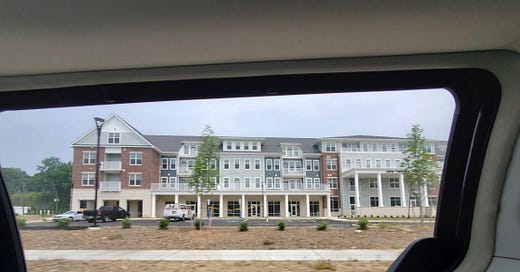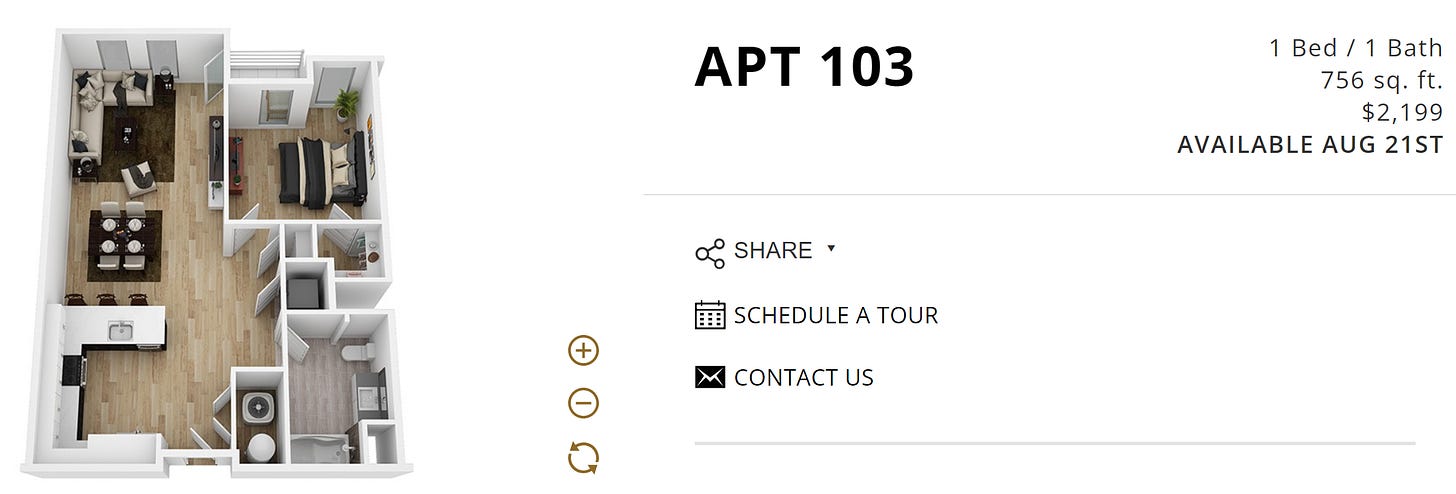Whenever I go back to New Jersey, I notice and talk about these types of buildings:
We have them all over Northern Virginia too.
And I just recently wrote about one of them, here.
So what are these? They’re called “5-over-1s,” which I used to think meant “five floors of residential over one floor of commercial,” but which really refers to the numbering of materials in the building code. The 5 refers to wood (and is typically three to five stories) and the 1 refers to masonry, which is the ground level. Building codes typically demand all-masonry construction for taller structures, which is very expensive. Permitting multistory apartment buildings to be made of wood (sometimes with purely decorative brick cladding) was a technocratic reform which sparked a lot of housing development.
Here’s a history and analysis of these buildings. (And actually, it looks like at least a couple of these are all wood without a masonry base.)
But that’s what they are technically. Economically, they’re just sort of the form multifamily development takes today, for a variety of reasons. That’s why in growing areas you see them and in older places without much new development you generally don’t—because they didn’t really exist back then. When growth happens, it usually takes the most common form.
In Somerville, New Jersey, there was an old, solid-looking brick building—which turned out to be framed with rotting wood. Many of the downtown-style structures in these old towns are quite simple and cheap, the 5-over-1s of their day.
Culturally, these buildings are also something. I have so many discussions about them with folks in central New Jersey and elsewhere about the various aspects of development: aesthetics, traffic, concerns about crime, “crowding,” what have you. But I get the sense that a lot of folks don’t really understand why these buildings are getting built. I’ve been asked, genuinely or rhetorically many times: Who’s living in these buildings? Who wants to live in them? The disbelief that they are filling any real market niche fuels the idea that they’re part of some “plan”: diminishing homeownership, “bringing in” low-income people, whatever.
So I want to pop the hood a little bit. Here are a few floorplans and prices from central Jersey apartment buildings of the sort in the photos above.
A 756-square-foot, one-bedroom for $2,199 a month:
Another one-bedroom at 726 square feet, starting at $2,228:
Here’s a larger, 895-square-foot one-bedroom starting at $2,075:
These prices seem very, very high—they approach those in Northern Virginia. But obviously the market can bear it. It’s not a plot. It’s a reason to question your assumptions about jobs and settlement patterns in a place that feels much sleepier and more remote than it is.
These are all standard-issue rooms in standard-issue buildings. In addition to the rooms there are a lot of facilities and on-site amenities in these types of buildings. I’ve lived in them and I’ve spent time with people who live in them. They’re nice. If you work a lot of hours it’s nice to come home to a little space of your own where things are managed and taken care of for the most part. It’s nice being surrounded by people but having distance and anonymity too.
So I’ll tell you who lives in these buildings.
I grew up in Flemington, New Jersey, outside town in a house on a large lot. I went to college in an expensive little town (not Princeton, maybe fortunately). Then I ended up moving down to Maryland for grad school, getting married, and moving to Northern Virginia where my wife and I bought a condo from 1972, and recently a house.
Now, what if after college I’d gotten a job in a pharma company or any number of other white-collar jobs in New Jersey, or maybe some job in New York City or a place like Jersey City? And what if I hadn’t gotten married or had a serious relationship until my late 20s? And what if, as is natural for someone out of school and with a real job, I wanted a place to live other than my old room in my parents’ house? (I think they would want that too.)
There has been very little new housing construction that is not single-family or townhomes in most of these communities—in Flemington or Clinton, or any number of similar places throughout central Jersey. And houses are sort of inherently family housing, unless a bunch of roommates informally split them.
One-bedroom apartments are for singles and maybe for young couples without kids yet. But the apartments that are available in these places are frequently older buildings that predate the mass downzonings of the 1970s. These are walk-ups or garden apartments. No front desk, no security, no gym, no pool, no lobby with a fireplace and nice seating, not necessarily an on-site or even local landlord.
These newer buildings, on the other hand, meet the standard you expect or grew up with as a middle-class young adult. Most of your neighbors will be other people like you. And renting—like a mortgage without a down payment—allows you to enjoy that standard for a few years while you save and see where your life takes you. So that explains “Why not a house?”
But what about “Why not Hoboken or Jersey City or Montclair or some place closer to the city that has more housing options?” Maybe you can’t afford it. Maybe you want to remain in or near the place you grew up. Maybe commuting from the edge of New York City to Princeton is a reversal of natural land-use patterns.
“Is there a limiting principle? Is there a way of preventing Flemington from becoming completely overbuilt and traffic-choked?” The limiting principle is the market. Surely, if nobody wants to live in these buildings, then that risk is quite limited. But they’ll build them anyway, people basically tell me. No, they won’t. The majority of these units are market-rate, not set aside for low-income folks. These builders obviously believe they can compete and turn a profit. I believe them.
I see why, to someone from a generation that had houses and kids in their mid-20s and saw that happen with one income, this all seems odd and in some sense just unbelievable.
But as someone who very well could have been a single high-earner for a decade after graduating college, and who would have wanted my own place in familiar surroundings, it’s intuitive to me what market these buildings fill.
And that’s really all there is to it.
Related Reading:
“Ugly Buildings” and Open Space
Thank you for reading! Please consider upgrading to a paid subscription to help support this newsletter. You’ll get a weekly subscribers-only post, plus full access to the archive: over 700 posts and growing. And you’ll help ensure more material like this!











I will never understand the borderline conspiracy theory that no one lives in these places. Business owners aren't in the business of paying money for empty units.
Personally I love seeing them. They are very useful for infill in neighborhoods I walk through and building apartments above shops is something we used to do all the time. This looks like a modern version of making places feel more connected.
Great piece!
I live in Madison, Wisconsin, which no doubt has some similar characteristics to your slice of Virginia ... a lot of upwardly mobile young people come to the Madison opportunity for the economic opportunity and living amenities. We have state government, city government, a big university, plus two small colleges, two very large and fast-growing tech companies with a national signature, and a shit-ton of small, local biotech and similar companies. Plus Madison is gorgeous and there's a decent amount going on (not like Chicago of course, but we have a little bit of culture.) All of this supports in-migration of a ton of young people.
Some of the youngsters moving in have kids or dogs and so they prefer to buy houses ... sometimes in my neighborhood of 1960's houses. But most of them are filling up the insane number of new 5-over-1s. These buildings are going up, en masse, in places that make no danged sense to long-time Madison inhabitants, including far, far outlying Madison and the suburbs. But there's nowhere else to put them, without knocking down other stuff.
Now don't get me wrong, we're knocking down old stuff too, but WOW does knocking down even the crappiest old stuff run into neighborhood complaints. They're redeveloping the site of a second-run movie theater right now. Nobody ever went to that place anymore, and it was an ugly little squat brick thing, but from the level of complaints, you'd think we were murdering Bucky Badger himself. Of course, the building replacing it is the same danged thing as you're building in Virginia. Here's a link.
https://captimes.com/news/community/despite-protest-song-city-advances-apartments-at-former-market-square-theater/article_8e60820a-6a76-535d-8d74-df08b5f8fa36.html
One new thing that they are doing in some parts of Madison, and even in Fitchburg, which is an inner-ring suburb, is new single-family housing on extremely small lots. We're talking lots as small as 2,800 square feet, though most are larger than that. Here's a google maps street view showing the development of the Fitchburg property.
https://www.google.com/maps/@43.0089617,-89.374248,3a,75y,127.94h,88.47t/data=!3m6!1e1!3m4!1s6L-GalJMQRugREkeJsLe4g!2e0!7i16384!8i8192
This type of construction isn't something that the market ever produced before, as far as I know. Even in the old Madison neighborhoods, basically all the lots are at least 5,000 SF, and the suburban standard is 10,000 -15,000 SF. Of course, these tiny-lot houses are provoking local bemusement as well. "Why would anyone want to live like that ... there??" Well, it's working. These buildings sell as fast as the builders can put them up.
Anyway, you might want to look around for some of these new tiny-lot neighborhoods out on the coast.